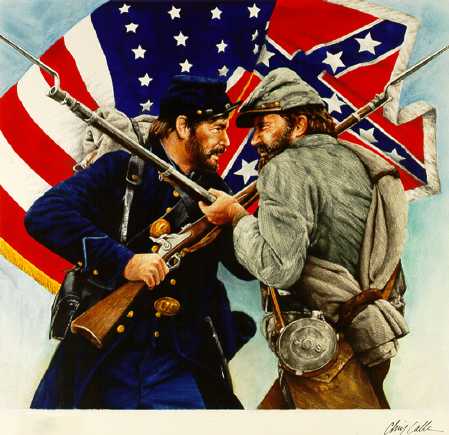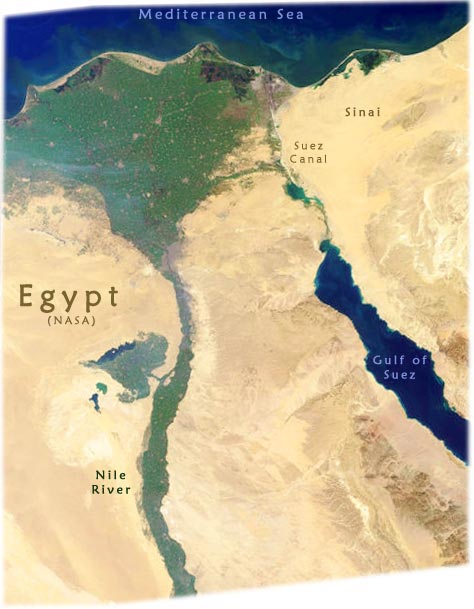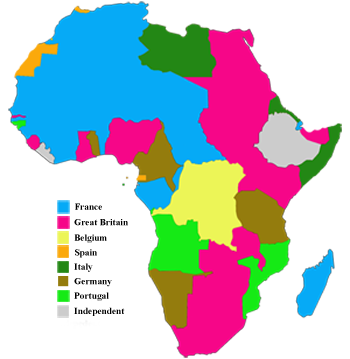European History
Chapter 25: The West and the World
Introduction:
 The Western nations began to extend their influence around
the world. A world economy developed as imports and exports traveled between
countries and places like Japan were forced open for trading. The great
migration occurred, which was a mass movement of people from Europe. New
imperialism began, meaning that Europeans countries tried to create large
political empires abroad, and continents like Africa were divided up by
European powers. Imperialism was justified as being for the good of the natives
as these inferior people were “civilized”. As nationalism became more
aggressive and militaristic, the stage was beginning to be set for the First
World War.
The Western nations began to extend their influence around
the world. A world economy developed as imports and exports traveled between
countries and places like Japan were forced open for trading. The great
migration occurred, which was a mass movement of people from Europe. New
imperialism began, meaning that Europeans countries tried to create large
political empires abroad, and continents like Africa were divided up by
European powers. Imperialism was justified as being for the good of the natives
as these inferior people were “civilized”. As nationalism became more
aggressive and militaristic, the stage was beginning to be set for the First
World War.
Objective:
To understand the role of new imperialism in the nineteenth century and the
changing interactions between countries.
Essential
Question: What caused the new imperialism in the nineteenth century?
Answer:
In short, the motives for imperialism have been summed up into the phrase “Christianity,
Commerce, and Civilization”. Religious arrogance plays a role as many Europeans
sought to spread Christianity to these uncivilized areas because it was the
superior religion. Extending a country’s empire can also have economic benefits
because direct control and low tariffs served as a profit motive. Superiority
through Social Darwinist and racist beliefs naturally encourages this spread of
control as the Europeans believed themselves to be above those they were
conquering. A prominent motive in the nineteenth century was to “civilize” the
natives. Ethnocentrism, the belief in the superiority of one’s own ethnic group
that therefore means they are morally obligated to teach their way of life, was
the thought that Europeans used to justify their actions.
Political Cartoons (from time period):
This imperialism cartoon appeared in August 15, 1900 issue of the
literary magazine Puck. In the
cartoon, animals representing different countries are battling over China (seen
as a dragon). During the Age of Imperialism, Asia was a popular target for
extending an empire and dividing among these foreign powers. The bear
represents Russia, the lion is Britain, the rooster is France, the eagle is
Germany, the two-headed eagle is Austria, Japan is the tiger and the bald eagle
is the United States. The artist gives the animals a vicious look as they hold
weapons, display sharp teeth, or outstretch their claws. The artist’s depiction
creates the feeling that imperialism in Asia was an uncivilized and ferocious
because of the animals’ harsh appearance and by comparing the countries to
beasts. China appears helpless and trapped as it is sprawled out on the ground
in the middle of the commotion. The bald eagle representing the United States
takes a back seat to the action in Asia as it stays back from the situation but
maintains a firm stance on the issue. This shows the United States position of
supporting the Open Door Policy, which states that countries should have equal
access to China’s ports that are open for trade. I think the use of animals in
this comparison is clever for an illustration of imperialism, and the cartoon
clearly displays the message of the conflict over China and the rush for
stronger empires. It seems like this scramble for land became barbaric at
times, which is supported in the cartoon. I believe that employing the harsh
and greedy practices to expand during this time was selfish and only
concentrated on the interests of the powerful countries.
 "The World's Plunderers" was created by Thomas
Nast and appeared in Harper's Weekly in 1885. In the image, Germany, Britain
and Russia are carving up the world with their imperialistic desires. They are
each carrying a bag with which they can gather their new holdings in. Asia and
Africa are the main countries that appear on the globe because they were the
main areas divided up during the period of new imperialism. India is separately
marked as it is observed by the British because it was the “jewel” the Britain’s
colonial empire. Nast situates Europe at the top of this world, displaying the
European power as it overlooks its foreign possessions. Nast is ultimately
opposed to imperialism, and he makes this known through his title. He uses the
word “plunderers” to describe Germany, Britain and Russia making them sound
like thieves taking what is not rightfully theirs. To me this seems like an
accurate description. These countries overstepped their boundaries too far and
took whatever they wanted no matter the costs. I like how Nast uses the words “grab
bags” to describe what the countries were holding because the word implies
taking something forcefully and without permission.
"The World's Plunderers" was created by Thomas
Nast and appeared in Harper's Weekly in 1885. In the image, Germany, Britain
and Russia are carving up the world with their imperialistic desires. They are
each carrying a bag with which they can gather their new holdings in. Asia and
Africa are the main countries that appear on the globe because they were the
main areas divided up during the period of new imperialism. India is separately
marked as it is observed by the British because it was the “jewel” the Britain’s
colonial empire. Nast situates Europe at the top of this world, displaying the
European power as it overlooks its foreign possessions. Nast is ultimately
opposed to imperialism, and he makes this known through his title. He uses the
word “plunderers” to describe Germany, Britain and Russia making them sound
like thieves taking what is not rightfully theirs. To me this seems like an
accurate description. These countries overstepped their boundaries too far and
took whatever they wanted no matter the costs. I like how Nast uses the words “grab
bags” to describe what the countries were holding because the word implies
taking something forcefully and without permission.
Political Cartoon (current):
This political cartoon about U.S. imperialism revolves around the
war in Iraq. The reasons for going to war are often debated. One reason that
has been stated for going to war is because of the threat of Iraqi weapons of
mass destruction, but one rumored cause is that the true reason is for oil.
This artist agrees with the argument that the United States’ personal interests
about oil really drove the country into war. In the cartoon, President George
W. Bush is listing the things the U.S. hopes to accomplish through a war with
Iraq, but the author highlights the term “oil” hidden within each statement.
The artist is saying that oil is the underlying reason. Personally, I do not
believe the artist’s opinion to be true. I think that the U.S. has gained
little in the area of oil when it comes to Iraq. In fact, in 2009 no U.S. oil
companies obtained long-term contracts during an auction for contracts that are
involved in the Iraqi oil industry.
U.S. Imperialistic?:


Yes:
- Hawaii- President William McKinley signed a joint resolution annexing the islands in 1898, and it remained a territory until it was granted statehood in 1959.
- Cuba- Cuba was pressured to add the Platt Amendment into their constitution in June 1901. This amendment gave the United States the power to intervene in Cuba’s internal affairs and rights to Guantanamo Bay.
- Philippines- The Filipinos objected to American annexation of their land. They rebelled and went to war with America. After an American victory in 1901, eventual independence was promised, but the Philippines did not gain this independence until 1946.
No:
U.S. Events:
- The United States recently gave its land around the Panama Canal back to the Panamanian government.
- U.S. troops have retreated or their
presence has been reduced in many countries where they have been based for
decades. Examples of this are in Saudi Arabia, Panama, Japan, and Germany.
2. In situations like the Gadsden Purchase, the Treaty of Guadalupe Hidalgo, and the Alaska Purchase, land was not just taken. Instead, compensation was given and payments were made.
U.S. Events:

American Civil War (1861-1865): The 11 Southern
States in the U.S. wanted to secede
from the Union for reasons like disputes over the issues of slavery,
trade and tariffs, and the doctrine of states' rights. The fighting
started at Fort Sumter, South Carolina in April 1861. Jefferson Davis led the
Confederate (Southern) states and Abraham Lincoln led the north. Some of the major
battles of the war include Bull Run, Antietam, Fredericksburg, Chancellorsville,
and Gettysburg. Robert E. Lee (leader of the Confederate army) surrendered to
Ulysses S. Grant (leader of the Union troops) at the Appomattox Court House in
April 1865.
Connection across continents: Officially, Britain and
France were neutral in the American Civil War. However, there was a possibility
that they would provide aid to the Confederates. When Lincoln issued the
Emancipation Proclamation, this problem was solved because the war became an
issue of slavery rather than secession. Britain and France could no longer
recognize the Confederacy because of controversy over the war’s new issue at
home.

New Immigration: Before 1890 immigrants came primarily from
Northern Europe (Britain, Ireland, and Germany). In 1890 this shifted toward “new
immigration” into the U.S. that came from Southern and Eastern Europe (places
like Italy, Austria, Hungry, Russia, and Asia). These immigrants came to find
jobs (factories, railroads, etc.), for religious freedom and for land. The main
entry point for European immigrants was Ellis Island in New York. Immigrants
faced discrimination from nativities and were often grouped into ethnic
communities. Most immigrants did not have money to move out of the cities, so
the population of major U.S. cities near to coast greatly increased.
Connection across continents: Europe experienced its “great
migration” in the nineteenth century, which is what caused the rush of new
immigrants into the United States. Overpopulation was becoming an issue in
Europe, so people left when they could no longer find land or many work opportunities.
Uprisings in the
Colonies:
Maji Maji Uprising
(1905-1907)
 The Maji Maji Uprising was a two-year rebellion of Africans
in Tanzania against German colonial rule. Germans forced the natives to grow cotton and build roads for European benefit.
The Maji Maji Uprising was a two-year rebellion of Africans
in Tanzania against German colonial rule. Germans forced the natives to grow cotton and build roads for European benefit.
Key Players:
Dr. Karl Peters- Founded the German Colonization Society.
Peters became the Tanzanian colonial governor and was given a nickname that
meant "Man with Blood on His Hands” because
of the violent treatment used toward the natives.
Kinjikitile Ngwale- A
prophet who claimed that sacred liquid, called Maji Maji, could repel German
bullets. He became a leader of the rebellion in German East Africa.
How it happened: After resentment toward the
oppressive German regime and a drought, the first African warriors moved
against the Germans in 1905 by attacking small German outposts and destroying
cotton crops. This revolt spread throughout the colony. At Mahenge in August 1905 several thousand
Maji Maji warriors attacke, but these warriors failed to overrun the Germans. On October 21, 1905 the Germans attacked the
Ngoni people killing men, women and children. The German’s also tried to
starve out the African people by destroying their crops.
Success?: An estimated 75,000 Maji Maji warriors were dead by 1907 and the
uprising was ultimately unsuccessful. However, it forced Kaiser Wilhelm's government to institute reforms in
their African colonies due to the potential cost of their oppressive rule.
Current Uprising:
Tunisian Revolution (also known as the Jasmine Revolution)


Country/Date: Tunisia, December 2010-2011(ongoing)
Key Players:
Mohamed Bouazizi- A
26-year-old fruit and vegetable vendor who set himself on fire in protest. This
action helped to start the revolution in Tunisia.
Zine El Abidine Ben
Ali- ruler of the country from 1987 – 2011. He and his wife, Leila Trabelsi, fled from the
country on January 14, 2011.
A group of educated
Tunisians- A group of Tunisians used Facebook and Twitter to organize
massive protests.
Fouad Mebazaa & Moncef Marzouki- Mebazaa was the first interim president of Tunisia followed by
Marzoiki, Tunisia's first democratically elected president.
How it happened: The Tunisian government was corrupt,
experiencing economic issues, and offered limited freedoms to its citizens.
These issues in addition to the incident with Bouazizi sparked the revolution.
Massive protests and demonstrations were organized and spread across the
country. After Ben Ali announced that he would not run again and promised
reforms, he fled the country.
Success?: One hundred and forty seven deaths resulted
from the revolution and Tunisia continues to face economic and political
struggles as it attempts a transition to democracy. The form of this government
is still undecided. The RCD, the party of Ben Ali’s government, was dissolved
and the country had its first free election in October 2011.
“Spotlight On the
Suez Canal”:

_Suez_canal_108_days_at_sea.jpg)
Who controls it: The Suez Canal is operated by the Suez Canal Authority of the Arab Republic of Egypt.
How often it gets used: The canal supports 8% of the world's shipping traffic and
almost 50 ships pass through the canal daily.
Why it is important today: This 120-mile-long canal, built in 1859-1869, dramatically reduces the transit time for trade worldwide by
connecting the Mediterranean and Red Seas. The canal is the
fastest way to cross from the Atlantic Ocean to the Indian Ocean.
Summary:
3 Things I Learned-
1. Africa
was divided between the European powers at an astonishing rate. In just a
matter of twenty years (1880-1900), almost the entire continent had been carved
up and fell victim to European imperialism.
2. Arab
Spring is a series of multiple uprising in the Middle East and Northern Africa,
beginning with Tunisia. In the cases of Tunisia and Egypt, a new government is
still forming and being molded into shape after the leader of the country was
forced to leave.
3. The
United States was responsible for “opening” Japan when Matthew Perry used
gunboat diplomacy, forcing Japan to open ports for trade.
2 Things That
Interested Me-
 1. Lin
Zexu’s letter to Queen Victoria about the opium trade was particularly interesting,
because I think he made some convincing (even though they ultimately didn’t
work) and strong points. One example that I found especially persuasive was the
fact that Britain did not even allow opium within its borders, so they recognize
the harm it can cause and thus it shouldn’t be allowed in China either.
1. Lin
Zexu’s letter to Queen Victoria about the opium trade was particularly interesting,
because I think he made some convincing (even though they ultimately didn’t
work) and strong points. One example that I found especially persuasive was the
fact that Britain did not even allow opium within its borders, so they recognize
the harm it can cause and thus it shouldn’t be allowed in China either.
2. Rudyard Kipling is popularly known for having
written The Jungle Book, but his more historically important contribution was actually his poem “The White Man’s
Burden”. This poem helped to justify imperialism by saying that the Europeans
should civilize the nonwhites to improve their standard of living.
What happened to the control
that the Europeans held in the African continent? Is any of that power still in
place today?



Are you pregennant
ReplyDeletemaby
ReplyDelete